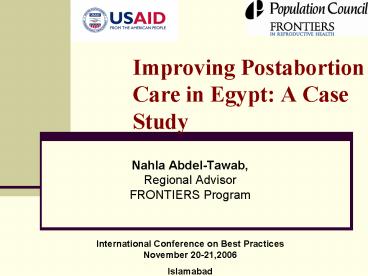Improving Postabortion Care in Egypt: A Case Study PowerPoint PPT Presentation
1 / 22
Title: Improving Postabortion Care in Egypt: A Case Study
1
Improving Postabortion Care in Egypt A Case
Study
- Nahla Abdel-Tawab,
- Regional Advisor
- FRONTIERS Program
International Conference on Best Practices
November 20-21,2006 Islamabad
2
Abortion a global problem
- According to WHO estimates, up to 15 of
pregnancy-related mortality worldwide is due to
abortion. - 70,000 women die as a result of complications
following unsafe abortion.
3
Why postabortion care
- Providing comprehensive treatment and counseling
to PA patients is the first step in saving
womens lives, reducing repeat unsafe abortions,
helping women to cope with miscarriages and
improving womens overall health.
4
Abortion in Egypt
- The National Maternal Mortality Survey (NMMS,
2000) showed that abortion (spontaneous or
induced) accounts for 4 of maternal deaths. - 11 of pregnancies in 2000 ended in spontaneous
abortion
5
Legal status of abortion in Egypt
- Egyptian law forbids abortion unless the mothers
life is in imminent danger - A physician who performs an abortion faces up to
three years in prison.
6
Program for improving postabortion care in Egypt
- In Egypt the Population Council conducted a
series of OR studies beginning with a small pilot
study in 1993 followed by other policy-related
research and interventions to influence policies.
7
Elements of Postabortion Care addressed in PC work
- Emergency treatment of incomplete abortion and
potentially life-threatening complications - Family planning counseling
- Links between postabortion emergency services and
the RH health care system
8
Emergency Treatment of Incomplete Abortion
- Manual vacuum aspiration under local anesthesia
e.g. para-cervical block - Treatment of complications
- Counseling about medical condition as well as
family planning
9
Caseload study
- A 1998 study conducted in 88 public hospitals
showed that one in every five obstetric
admissions was for postabortion treatment. - (Huntington et al., 1998)
10
OB/GYN Department Admissions During 30 Day Period
in Egyptian Public Sector Hospitals
Certainly Induced 5
Probably Induced 2
Possibly Induced 58
Spontaneous 35
Type of OB/GYN Admission (n22,656)
WHO Classification Scheme (n4,153 postabortion
patients)
11
1994 Pilot Study
- Two sites (El Galaa El Menia hospitals).
- Changes introduced through intensive clinical
training to use MVA under local anesthesia with
minimal pain control medications and to provide
high quality counseling to postabortion patients.
- The study revealed substandard quality of PAC
services and revealed feasibility of rapidly
improving outcomes related to both providers and
patients.
12
1995-1998
- A series of OR studies which contributed to the
growing body of international evidence and
created an environment for scientific study of
abortion done in collaboration with EFCF. - Small scale expansion program
- Caseload study
- Womens perceptions of abortion
- Cost analysis of postabortion services
- Effects of counseling the husbands of
postabortion patients
13
Expansion program
- The pilot study was followed by a small scale
expansion of services from two hospitals to 10
hospitals (university, teaching and MOHP). - The goal of the expansion was to influence
national policy by engaging high-level policy
advisors. - The program also created a pool of experienced
postabortion care clinicians.
14
1998 - 2000
- Follow-up of participating hospitals to ensure
adherence to improved PAC. - Institutionalization of improved PAC in selected
university and teaching hospitals (EFCF) - Elements of the PAC service delivery package were
implemented within the MOHPs essential obstetric
care program. - MVA is specified as the procedure of choice for
treatment of incomplete abortion at than 20 weeks
gestation.
15
However,
- The protocol does not use the term postabortion
but uses bleeding in pregnancy - The protocol does not emphasize integration of FP
counseling.
16
FRONTIERS work on PAC (2004-2006)
- Creating linkages between safe motherhood and FP
programs testing two models of providing FP
services to postabortion patients
17
Linking FP with Postabortion Care
- Model I
- Improved PAC FP counseling referral to a FP
clinic - Model II
- Improved PAC FP counseling offering FP methods
18
Linking FP with Postabortion Care
- Results
- Both models are feasible to implement
- Model II associated with improved quality of
counseling - Equal levels of contraceptive use at 3 months
post discharge (25 - 30) - Very low acceptance of FP methods on the ward
19
Accomplishments
- Accumulating a body of evidence on improving
postabortion care within the Egyptian context - Desensitization of policy makers and health
professionals to the topic of postabortion care - Paving the way for more interventions for
improving postabortion care - Institutionalization of improved PAC in three
leading university and teaching hospitals
Following work initiated by the Population
20
Accomplishments
- Three hospitals have become training centers on
improved PAC. - Improved PAC is now part of the graduate program
for OB/Gyn in two universities. - Elements of the PAC service delivery package were
implemented within the MOHPs essential obstetric
care program. - TAKAMOL and FRONTIERS programs currently working
on integrating family planning counseling into
service delivery protocols for Emergency
Obstetric Care.
21
Lessons learned
- Positioning the problem within the health care
domain as opposed to religious, legal or social
arenas - Building trust with the government
- Little emphasis on distinguishing between induced
or spontaneous abortion - Work with partners e.g. reputable research
organizations, service delivery CAs, safe
motherhood and postpartum FP programs
22
Remaining challenges
- Ensuring continuity of supplies of MVA
instruments - Integration of FP and curative care services
- Integration of PAC within medical and nursing
school curricula - Womens empowerment to negotiate number of
children and timing of pregnancies

